Ciao chows' journal
So Smooth, So Chow Chow!
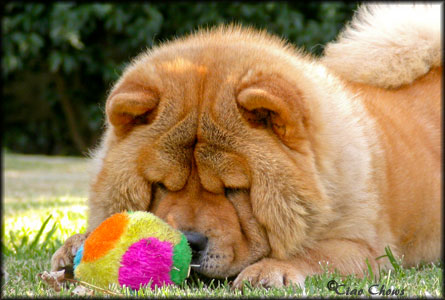
THERE IS VERY LITTLE ROOM FOR ILLUSION WHEN SHOWING, BREEDING AND LIVING WITH SMOOTH (SHORT HAIR) CHOW CHOWS. ACTIVELY USING THEM IN A BREEDING PROGRAM & IN SHOWING, FORCES PERSPECTIVE AND PROVIDES A LEAP FORWARD IN THE QUEST FOR GENERAL CHOW CHOW EXCELLENCE. SMOOTH CHOW CHOWS - ALL THAT AND THEN SOME!
FIRST IMPRESSIONS
From the moment that the first smooth chow chow stepped out of his transport crate over a decade ago, I acknowledged that this was the most important thing that had happened to me as a chow chow breeder. He had less length of hair and was so incredibly neat, but at the same time, he was all chow chow. The same scrutinizing expression, aloof nature and gentlemanly manners, plus the bonus of visually being confronted with the way the chow chow is put together underneath the better known, longer hair.
 TEMPERAMENT COMPARISONS
TEMPERAMENT COMPARISONS
Many a prospectie buyer share the same first question - is the smooth (short hair) chow chow's temperament different to that of the rough (long hair) chow chow?
My personal experience with the smooth variety has proved that temperaments are no different purely because of coat length.
There are differences in temperaments between all chow chows - markedly so at times - mostly because of hereditary traits (bloodlines) & also because of the way it has been raised. Using human personalities to describe these temperaments, one can say there are "serious", "easy-going", "interactive", "couch-potato", "softy", "mischievous", "lively" and sadly, sometimes even "aggressive" temperaments, but they occur equally in both coat varieties of the chow chow. Although temperament is definitely hereditary, it is also shaped by the environment, thus the best answer about a prospective chow chow puppy's temperament - chosen to suit your family's needs - would come from an unbiased and understanding breeder. 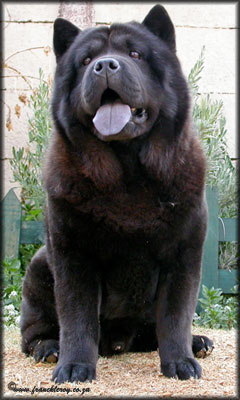
BONING AND HEAD
The variety in appearance of boning and head occurs in both types. The amount of hair on a rough exaggerates one's perception of 'heaviness' (amount) of bone or head. However, the frequently expressed misunderstanding by prospective buyers that smooth chow chows have less boning (not as thick legs) and not as closed faces (not as heavy head & muzzle) as rough chow chows is not surprising.
A heavy headed rough chow chow will look much heavier than it's exact same smooth counterpart. And the same goes for the more open faced dogs. Please don't feel embarrassed that you are fooled by the hair, as so often a judge in the show ring is unable to perceive this illusion created.
However, as a prospective chow chow owner your most important consideration should be temperament and health, as these affect the quality of life your dog has and secondly the length of time (life) you will have to enjoy his/her company. Only after knowing the temperament and likely health your dog will have, should you then move to "preferred looks". This is done by visiting various breeders' websites/dogs & establishing who has most of the criteria that you would like in a future chow chow companion. Thereafter, be prepared to wait, particularly for smooths, as these are relatively rare and in South Africa, quite popular.
HAIR AND HEAT
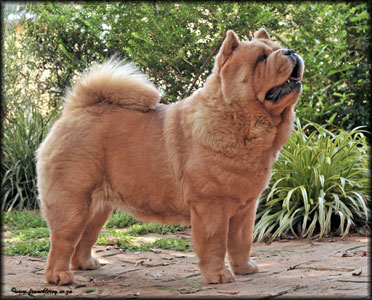 One of the first questions people ask upon seeing a rough chow chow in summer: "Is it not feeling too hot?". These people may be standing next to the chow chow & a metre away is a Staffordshire Terrier. Both are panting because of heat and excitement. But the chow chow is immediately singled out related to coat. It would be wise to remember that hair is a protection for an otherwise sensitive skin. It is also necessary to understand that both the smooth and the rough have a double coat. This means that there is a layer of short, thick, soft, fluffy 'undercoat' and a layer (spread inbetween) of coarse, longer, straighter hair 'guard hair'. In summer, both varieties lose hair - they shed the undercoat which maintains heat. The guard hair remains to protect the skin. In this way the chow chow regulates it's own body temperature.
One of the first questions people ask upon seeing a rough chow chow in summer: "Is it not feeling too hot?". These people may be standing next to the chow chow & a metre away is a Staffordshire Terrier. Both are panting because of heat and excitement. But the chow chow is immediately singled out related to coat. It would be wise to remember that hair is a protection for an otherwise sensitive skin. It is also necessary to understand that both the smooth and the rough have a double coat. This means that there is a layer of short, thick, soft, fluffy 'undercoat' and a layer (spread inbetween) of coarse, longer, straighter hair 'guard hair'. In summer, both varieties lose hair - they shed the undercoat which maintains heat. The guard hair remains to protect the skin. In this way the chow chow regulates it's own body temperature.
For those individuals who simply have to shave a chow chow, please, never buy a rough chow chow again. Please buy a smooth. Apart from it not making sense buying a rough for it's long coat only to shave it all off, shaving hair often damages the coat permanently. The smooth chow chow tends to look much neater than the rough chow chow for a longer period after brushing, and certainly looks much neater than the shaved chow chow. The smooth also is arguably a lot less work in terms of time spent brushing in coat maintenance.
Occasionally some people report a rough chow chow having a much higher level of activity after shaving. This is often the chow chow of which the owner does not have enough time to spend on correct daily maintenance of the long hair - and therefore it has been shaved. It would appear that this chow chow is so relieved to no longer be discomforted by a neglected coat, that it does feel very happy to have it all taken care of by means of a 'short cut'.
BRUSH COAT, FLAT COAT, HORSE COAT, SMOOTH COAT
Using terms common to Sharpei's, some breeders debate varieties of short hair. Generally speaking the hair of a smooth is anywhere from 2cm - 6cm in length, the longer hair is inareas where vital body parts are to be protected. 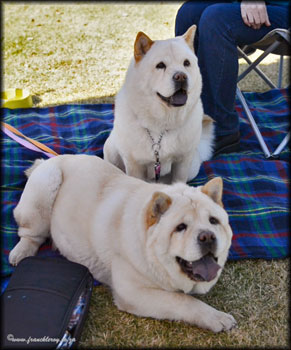 This is a correct, natural way of growth. It would be unfair to define ('name') a coat's natural appearance judged upon show ring presentation, as exhibitors often will groom the hair to look a certain way, hoping thereby to improve chances of winning.
This is a correct, natural way of growth. It would be unfair to define ('name') a coat's natural appearance judged upon show ring presentation, as exhibitors often will groom the hair to look a certain way, hoping thereby to improve chances of winning.
Some pride themselves upon 'brush coated' smooths - where it is claimed the coat is more offstanding (guardhair standing away from the body). Others pride themselves upon the 'flat coated' smooths, claiming them to be historically more correct, (where the guard hair lies somewhat tighter to the body). Even others claim the shorter the hair, the more correct the smooth. Yet within all of these claims, one will find the undercoat makes the hair generally offstanding from the skin, a basic requirement which rovides a regulatory layer between the skin & the elements.
Nature provides for beautiful differences within the scope of trueness to a variety - accross many species, plants, etc. Just as some rough chow chows have longer hair than others, so some smooth chow chows likewise have shorter hair than others. It is fine for breeders to pride themselves upon the beauty of the coat type produced within their chosen variety, as long as it remains true to type, without dysfunction brought about by exaggeration of any coat property.
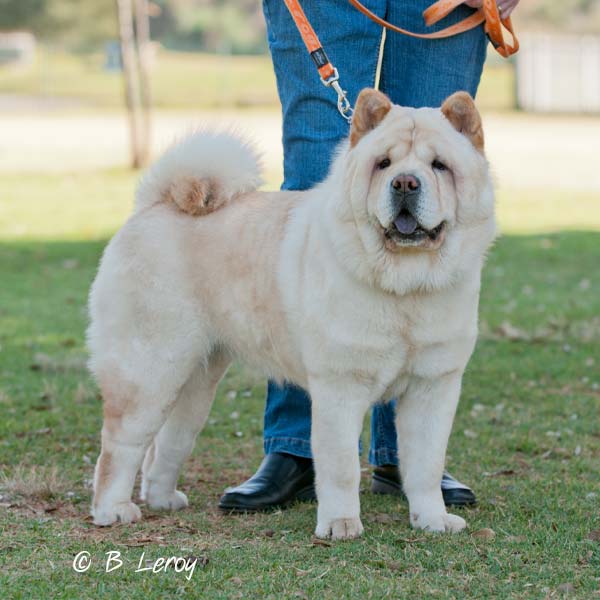
Rough or smooth, enjoy your chow chow,
for it remains ALL CHOW CHOW!



